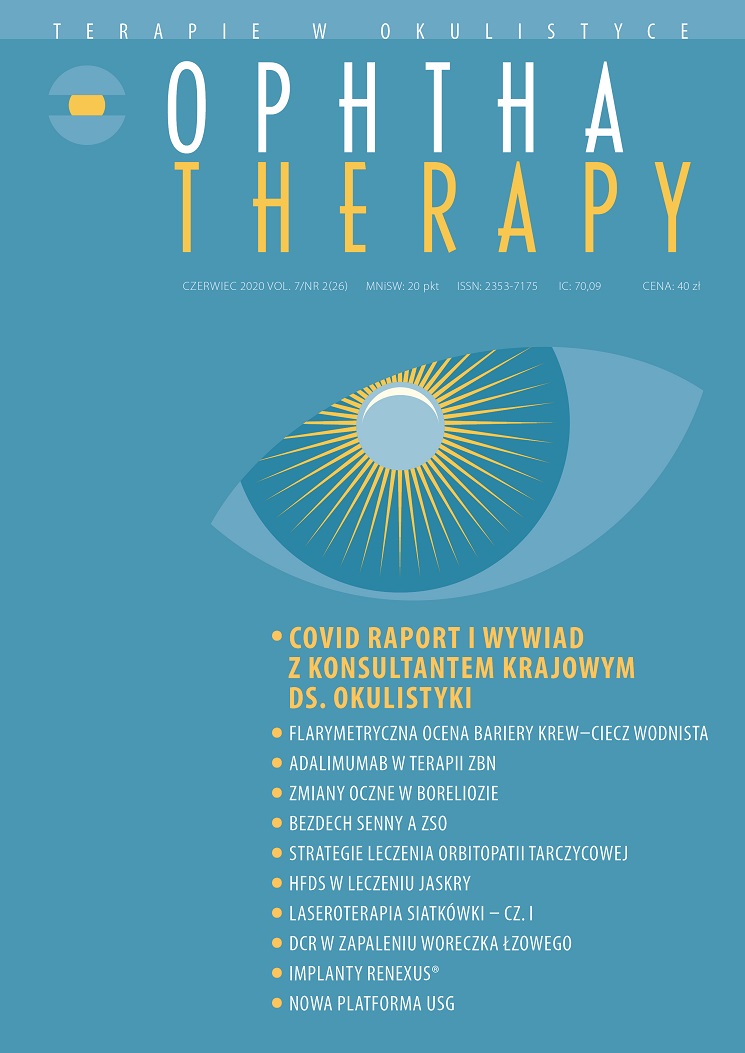Zastosowanie laseroterapii w chorobach siatkówki. Część I ? metody laseroterapii Artykuł przeglądowy
##plugins.themes.bootstrap3.article.main##
Abstrakt
Choroby siatkówki stanowią dużą grupę schorzeń narządu wzroku. W leczeniu wielu z nich od lat z powodzeniem stosowana jest laseroterapia. Mimo prób wprowadzania do terapii innych metod leczniczych nadal pozostaje jedną z głównych opcji terapeutycznych. W pracy przedstawiono przegląd piśmiennictwa dotyczący zastosowania laseroterapii w chorobach siatkówki, z uwzględnieniem nowych rodzajów i sposobów laseroterapii. Pracę podzielono na trzy części. W części pierwszej, publikowanej w niniejszym numerze przedstawiono metodykę i rodzaje zabiegów laserowych. W kolejnych numerach pisma ukażą się: część druga, zawierająca przegląd piśmiennictwa dotyczący laseroterapii w retinopatii cukrzycowej, cukrzycowym obrzęku plamki oraz chorobach naczyniowych siatkówki (nr 3), i trzecia, ukazująca przegląd piśmiennictwa dotyczący laseroterapii w przedarciach oraz chorobach zwyrodnieniowych siatkówki, retinopatii wcześniaków, zwyrodnieniu plamki związanym z wiekiem oraz innych chorobach siatkówki (nr 4).
Pobrania
##plugins.themes.bootstrap3.article.details##

Utwór dostępny jest na licencji Creative Commons Uznanie autorstwa – Użycie niekomercyjne – Bez utworów zależnych 4.0 Międzynarodowe.
Copyright: © Medical Education sp. z o.o. License allowing third parties to copy and redistribute the material in any medium or format and to remix, transform, and build upon the material, provided the original work is properly cited and states its license.
Address reprint requests to: Medical Education, Marcin Kuźma (marcin.kuzma@mededu.pl)
Bibliografia
2. Kuklo P, Kuklo M, Pieczyński J et al. Laserowe leczenie chorób obturacyjnych naczyń siatkówki. Okul Dypl. 2019; 9(6): 5-9.
3. Meyer-Schwickerath G. Light coagulation. Buch Augenarzt. 1959; 33: 1.
4. Bowling B. Okulistyka Kliniczna Kanski. Wydanie 8. Edra Urban & Partner, Wrocław 2017: 506-8, 520-56, 561-9, 603-4, 615-7, 623-30, 681-700, 797-8.
5. Latalska M, Mackiewicz J. Cukrzycowy obrzęk plamki ? diagnostyka i leczenie. Okul Dypl. 2018; 8(2): 5-10.
6. Vujosevic S, Bottega E, Casciano M et al. Microperimetry and fundusautofluorescence. In: diabetic macularedema: subthreshold micropulse diode laser versus modified early treatment diabetic retinopathy study laser photocoagulation. Retina. 2010; 30(6): 908-16.
7. Lavinsky D, Cardillo JA, Melo LA. Randomized Clinical Trial Evaluating mETDRS versus Normal or High-Density Micropulse Photocoagulation for Diabetic Macular Edema. Invest Ophtalmol Vis Sci. 2011; 52(7): 4314-23.
8. Latalska M, Prokopiuk A, Wróbel-Dudzińska D et al. Subtreshold micropulse yellow 577nm laser therapy of diabetic macular edema in rural and urban patients of south-eastern Poland. Ann Agric Environ Med. 2017; 24(1): 96-9.
9. Scholz P, Altay L, Fauser S. A Review of Subthreshold Micropulse Laser for Treatment of Macular Disorders. Adv Ther. 2017; 34(7): 1528-55.
10. McHugh J, Marshall J, Ffytche T et al. Macular photocagulation of human retina with a diode laser: a comparative histopathological study. Lasers Light Ophthalmol. 1990; 3(1): 11-28.
11. Vogel A, Birngruber R. Temperature profiles in human retina and choroid during laser coagulation with different wave lengths ranging from 514 to 810 nm. Lasers Light Ophthalmol. 1992; 5(1): 9-16.
12. Peyman G, Raichand M, Zeimer R. Oculareffects of various laser wave lengths. Surv Ophthalmol. 1984; 28(5): 391-404.
13. Friberg T, Karatza E. The treatment of macular disease using a micropulsed and continuous wave 810-nm diode laser. Ophthalmology. 1997; 104(12): 2030-8.
14. Friberg T, Venkatesh S. Alteration of pulse configuration affects the pain response during diode laser photocoagulation. Lasers Surg Med. 1995; 16(4): 380-3.
15. Mainster M. Wave length selection in macular photocoagulation: tissue optics, thermal effects, and laser systems. Ophthalmology. 1986; 93(7): 952-8.
16. Gawęcki M. Micropulse Laser Treatment of Retinal Diseases. J Clin Med. 2019; 8(2): 242.
17. Gaca-Wysocka M, Grzybowski M. Zastosowanie lasera nanosekundowego 2RT w leczeniu cukrzycowego obrzęku plamki. OphthaTherapy. 2017; 4(2): 81-4.
18. Chidlow G, Shibeeb O, Plunkett M et al. Glial cell and inflammatory responses to retinal laser treatment: comparison of a conventional photocoagulator and a novel, 3-nanosecond pulse laser. Invest Ophthalmol Vis Sci. 2013; 54: 2319-32.
19. Pelosini L, Hamilton R, Mohamed M et al. Retina rejuvenation therapy for diabetic macular edema. Retina. 2013; 33: 548-58.
20. Laser mikropulsowy z funduskamerą Navilas 577. Opis producenta. http://www.consultronix.pl/oferta/prod/navilas-577.
21. Maltsev D, Kulikov A, Uplanchiwar B et al. Direct navigated laser photocoagulation as primary treatment for retinal arteria macroaneurysms. Int J Retina Vitreous. 2018; 4: 28.
22. Ramel J. Treatment of macroaneurisms in macular oedema: Navigated laser leeds the next generation of photocoagulation therapy. Ophthalmology Times. 2018; 14(10): 27.

